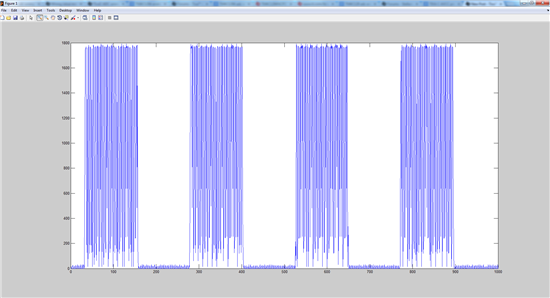Hi people,
When digitalizing a 300 Hz square wave with a ADC triggered by a timer at 50 KHz, I don't get a pure square wave.. I have got a lot of glitches (several VCC to almost 0 transitions).
I am using a TIVA C TM4C1294XL evaluation kit.
The ADC is configured with a sequencer 3 and triggered by a 50000 Hz timer:
/**
* --------------------------------------------------------------------------
* Timer0
* --------------------------------------------------------------------------
*/
/* Configure the timer 0 as a 32-bit Timer in periodic mode. It combines timer 0A and
* Timer 0B (General Purpose Timer). TIMER0_BASE is the start of the timer registers for
* Timer0 in, the peripheral sectio nof the memory map.*/
TimerClockSourceSet(TIMER0_BASE, TIMER_CLOCK_SYSTEM);
TimerConfigure(TIMER0_BASE, TIMER_CFG_PERIODIC);
/*This function controls the ADC trigger output for the specified timer.
* If the bEnable parameter is true, then the timer’s ADC output trigger is enabled;
* otherwise it is disabled.*/
TimerControlTrigger(TIMER0_BASE, TIMER_A, true);
// Maintain this disabled!
TimerLoadSet(TIMER0_BASE, TIMER_A, (ui32SysClkFreq / (ap.ac_signal_frequency)) / 2 - 1);
TimerDisable(TIMER0_BASE, TIMER_A);
// Middle priority
IntPrioritySet(INT_TIMER0A, 1);
The ADC initialization code after the clocks and gpios configuration is:
/**
* --------------------------------------------------------------------------
* ADC
* --------------------------------------------------------------------------
*/
/* ADC 0 - Disable */
ADCSequenceDisable(ADC0_BASE, 3);
/* ADC 1 - Disable */
//ADCSequenceDisable(ADC1_BASE, 3);
/* ADC0 - Sample Sequencer 1 - Timer Trigger the Sampling and Highest Priority*/
ADCSequenceConfigure(ADC0_BASE, 3, ADC_TRIGGER_TIMER, 0);
/* ADC1 - Sample Sequencer 1 - Timer Trigger the Sampling and Highest Priority*/
//ADCSequenceConfigure(ADC1_BASE, 3, ADC_TRIGGER_TIMER, 0);
/* ADC 0 - ADC_CTL_TS is the channel linked to the CH1*/
ADCSequenceStepConfigure(ADC0_BASE, 3, 0, ADC_CTL_CH1 | ADC_CTL_SHOLD_4 |ADC_CTL_IE |ADC_CTL_END);
/* ADC 1 - ADC_CTL_TS is the channel linked to the CH1*/
//ADCSequenceStepConfigure(ADC1_BASE, 3, 0, ADC_CTL_CH2 |ADC_CTL_IE |ADC_CTL_END);
/* ADC 0 - Enable the ADC sequencer 1.*/
ADCSequenceEnable(ADC0_BASE, 3);
/* ADC 1 - Enable the ADC sequencer 1.*/
//ADCSequenceEnable(ADC1_BASE, 3);
/* ADC 0 - Enables the specific vector associated with ADC0_BASE.*/
IntEnable(INT_ADC0SS3);
/* ADC 1 - Enables the specific vector associated with ADC1_BASE.*/
//IntEnable(INT_ADC1SS3);
/* ADC 0 - Enables a specific event*/
ADCIntEnable(ADC0_BASE, 3);
/* ADC 1 - Enables a specific event*/
//ADCIntEnable(ADC1_BASE, 3);
The ADC ISR code is:
/**
* \brief This function utilizes the ADC ISR to acquire samples from the ADC.
* @param void :
* @return void :
*/
void ADC0IntHandler(void)
{
uint32_t ui32ADC0Value;
/* ADC 0 - Clear the INterrupt Flag*/
ADCIntClear(ADC0_BASE, 3);
/* Disable Timer */
TimerDisable(TIMER0_BASE, TIMER_A);
/* ADC 0 - Get the data */
ADCSequenceDataGet(ADC0_BASE, 3, &ui32ADC0Value);
/* ADC 0 - Un-pend an interrupt */
IntPendClear(INT_ADC0SS3);
ram_store_b1[sf.nsamples_bridge1] = ui32ADC0Value;
sf.nsamples_bridge1++;
if(sf.nsamples_bridge1 >= ap.maximum_nsamples ) //&& sf.nsamples_bridge2 >= ap.maximum_nsamples)
{
sf.machine_state = MEASURE_COMPLETE_STATE;
}
else
{
/* Enable the timer */
//TimerLoadSet(TIMER0_BASE, TIMER_A, (ui32SysClkFreq / (ap.ac_signal_frequency)) / 2 - 1);
TimerEnable(TIMER0_BASE, TIMER_A);
}
}
Thank you.


